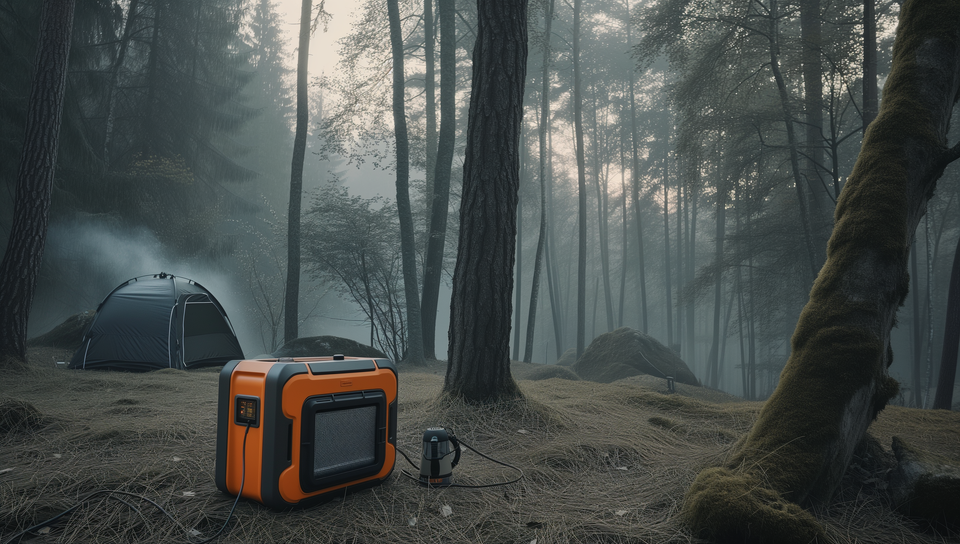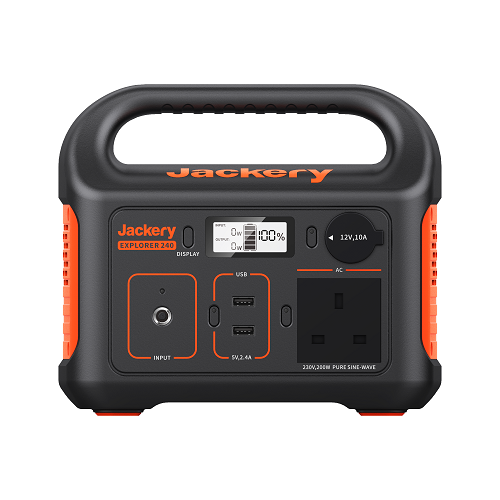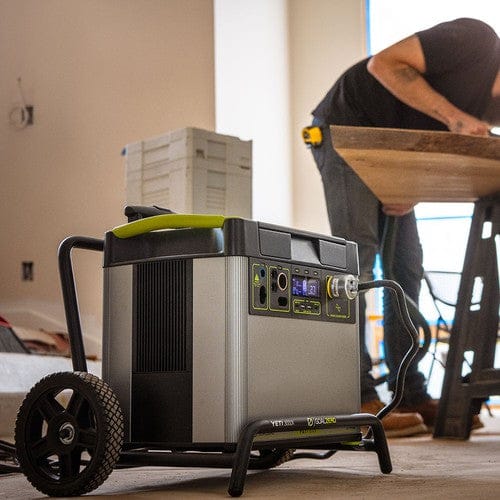How Long do Portable Power Stations Last

Do you like to spend time outside, or do you work frequently in areas without power outlets? If this is the case, a portable power station may come in handy. It's similar to a power pack that can keep your electronic devices running even when you're separated from civilization.
You may be wondering how long these portable power plants will last and what you can do to extend their service life. Don't worry; we've got your back! We'll explain the the ins and outs of these portable power stations have and give you practical advice on making the most of them.
What Are Portable Power Stations?
A portable power station is essentially a big battery that helps you carry electricity with you wherever you go. They have various outlets, including AC, DC, and USB ports, which can power things from your smartphone to smaller devices.
The main technology in most portable power stations is the Lithium-ion (Li-ion) battery. Li-ion batteries are superior because they hold a lot of power without losing their charge quickly and can be recharged many times.
Plus, they're lighter and more compact than old-school batteries, making them ideal for portable energy needs.
What Makes Portable Power Stations Last Longer or Shorter?
Battery Capacity
The amount of energy a power station can hold, measured in watt-hours (Wh), significantly impacts its life. If the capacity is bigger, the power station will usually last longer because it can be charged only sometimes. The energy capacity tells you how much juice a station has to work with and give out. More capacity can lead to a longer life for the battery because it isn't fully charged and used up as quickly.
The life of the battery is extended by following proper charging patterns. Not draining the battery completely before recharging, avoiding overcharging, and storing the power station at moderate temperatures are excellent practices. Taking care of your battery this way can help maximize its lifespan.
Charge Cycles
What happens during a charge cycle? Well, when you charge up the battery and then use the power until it's low, that counts as one complete cycle. Lithium-ion batteries don't last forever; they usually have a limit of 500 to 1000 of these complete cycles. After you hit that number, your battery won't hold as much power as it did initially.
Usage Patterns
If you constantly use your battery and push it to its limits, it will get worn out faster. On the other hand, if you use it gently and not too often while taking good care of it, it could stick around for a longer time. Remember, a charge cycle uses most of the battery's juice and then charges it fully again. That helps us determine how long our battery will stay in good shape.
Every time you go through a discharge and recharge, the battery loses a bit of its ability to store energy. Over many cycles, you'll notice the battery running out quicker than when it was new. That happens with Li-ion batteries over time; anyone using them should expect it.
The more often and more heavily you use your portable power supply, the quicker its battery wears out. Totally draining the battery or almost doing so adds strain, making it wear out quicker. However, your battery might last longer if you're using it less and taking excellent care of it.
To keep your battery strong for as long as possible, use it wisely. Please don't wait until it's completely dead to charge it up; steer clear of overcharging it, and keep it somewhere that's not too hot or cold. Good habits like these can significantly affect how long your battery lasts.
Battery Life Tips
If you want your battery to last longer, it's best to charge it a bit at a time. You should use your lithium-ion (Li-ion) batteries until they're about 20% full and then plug them in. Running them down to zero before recharging ain't the way to go.
Environmental Factors
Battery health can be badly affected by really hot or cold weather. Too much humidity can also damage the electronic parts and the cells inside the battery.
Where you use your portable power station is crucial for keeping it working well. Being too hot or too cold can mess up battery performance and shorten its life.
Hot weather rushes up the chemical reactions in the battery, making it wear out quickly. Bad weather conditions can adversely affect the battery's performance, making it challenging to function correctly.
Too much moisture in the air can cause parts of the battery to rust, making them work less efficiently and shortening the battery's life.
Average Lifespan of Portable Power Stations
How long it will last depends on what brand or model it is and how you use it. More expensive models might last longer because they're made with better materials and battery tech.
If you're wondering how long your portable power station will keep working, here's the deal: with average use, expect a solid 3 to 5 years of service from a quality unit. Of course, this can change based on factors like the make and how you handle it.
What do these specs look like when talking about real-life items?
Specific links are affiliate links for Amazon, and BeforeTheCart.com might make some money off them. But don't worry, this doesn't change how we decide how good something is.
Look at the Jackery Explorer 240. It's a power station with a reasonable price tag that's great for folks who love to go on short adventures or need backup power at their place during sudden blackouts.

People have said the Jackery, which has a 240Wh capacity, does a great job of keeping electronics charged during short trips. If you take care of it and follow the instructions, an average person might find it stays good for years.
At the top end, there's the Goal Zero Yeti 3000X. This powerhouse offers an impressive 3032Wh capacity and comes with a hefty price. It's designed to meet significant power needs, like running essential home appliances during a blackout or running tools at construction sites.

Those who use Goal Zero talk about how tough and reliable the Yeti is over time. With the correct attention, this premium power station can be a dependable energy source for a long time. Some owners report it works great even after 5 years.
How long your portable power station lasts depends on how you take care of it. Regular checks, storing it correctly, and using it wisely can help make your device last longer. So, whether you pick a more affordable option like the Jackery or go for the high-capacity Goal Zero Yeti, you can count on them to supply power for your outdoor activities and emergency preparedness for a while. Just remember to keep it charged and store it safely; it will continue to provide power when needed!
Tips for Extending the Lifespan of Your Portable Power Station
- Proper Charging Practices: Avoid overcharging and deep discharging. It's best to keep the battery level between 20% and 80%.
- Storage and Maintenance: Store the power station in a cool, dry place. Avoid exposure to extreme temperatures and moisture.
- Avoiding Extreme Conditions: Don't leave the station in a hot car or in direct sunlight for extended periods. Similarly, avoid using it in excessively cold environments.
- Regular Firmware Updates: Manufacturers often release software updates that optimize battery performance and efficiency. Keeping the power station updated ensures optimal functioning.
Choosing a Durable Portable Power Station
When shopping for a portable power station, consider:
- Battery Type: Li-ion batteries are typically the best choice for portability and lifespan.
- Build Quality: Look for sturdy construction that can withstand regular use and transport.
- Warranty: A longer warranty period can be a good indicator of the manufacturer’s confidence in their product.
- Brand Reputation: Opt for brands with positive reviews and a track record of reliability.
Real-World Applications and User Experiences
User experiences vary widely, with some reporting years of reliable service, while others encounter issues sooner. Factors such as how often it's used, for what purpose, and maintenance practices play significant roles in determining longevity. Users have reported using their stations for everything from powering CPAP machines during camping trips to running essential home appliances during power outages.
Signs of Battery Degradation and Replacement
If you use a portable power station, it's important to know when your battery is getting old. Just like any battery that you can charge again and again, the ones in a portable power station will wear out after a while.
Knowing the signs of an aging battery lets you figure out when it’s time to get a new battery or maybe even a new power station. A big clue that your battery isn’t what it used to be is if it doesn't last as long anymore.
If you notice that your power station runs out of juice quicker than before when using it the same way, it means the battery isn’t holding as much power. This drop in how well it works gets more obvious as time passes.
Another thing to watch for is how long it takes to charge. Your power station used to charge up in a set time, right? If it starts taking way longer to fill up, it probably means the battery isn’t working as well as it used to.
You might also see that the power station isn't working right. If it has trouble keeping your gadgets going, turns off on its own when it shouldn't; these are signs of a bad battery. When these problems pop up, check the user guide or talk to the people who made it.
They'll have tips for changing the battery or might tell you to consider getting the latest model. Staying alert to your power station's battery condition means you can count on it for power whenever you need it.
Remember, staying on top of your power station's battery health ensures you always have reliable power when needed.
Typical Symptoms of Battery Wear
You might notice several signs if your portable power station's battery is worn out. Recognizing these can help you determine when it's time for maintenance or a new battery. People and facts point to these usual symptoms:
- Reduced Capacity: The most straightforward sign to spot is lower capacity. Your power station will hold less charge than before, so you can't use it as long.
- Extended Charging Time: Old batteries take longer to charge. A few hours can become much longer.
- Reduced Performance: Your power station may also have trouble running devices or not work, showing the battery isn't as good.
- Unexpected Shutdowns: An old battery can cause your power station to turn off by itself, even if it says there's enough charge.
- Physical Signs: If the battery swells, leaks, or looks different, that's a severe warning sign.
| Symptom | Early Stages | Advanced Stages |
|---|---|---|
| Reduced Capacity | Run times decrease slightly | Run times greatly reduced | Extended Charging Time | Charging time increases slightly | Takes much longer to charge |
| Reduced Performance | Minor issues in performance | Major difficulties in powering devices |
| Unexpected Shutdowns | Infrequent shutdowns | Regular and sudden shutdowns |
| Physical Signs | Barely noticeable changes | Clear signs of damage |
Safety Considerations and Best Practices
Using portable power stations safely is vital. They're super handy but come with safety issues that users must know to avoid accidents and make their device last longer.
To start, remember that these power stations have strong batteries that hold a lot of energy. If misused or damaged, they could catch fire or explode. So, always be gentle with your power station; don't drop it, poke it, or leave it in hot or cold places. Also, always use the power station. Make sure you run your power bank on a level, firm surface. This prevents it from tipping over or falling, which could cause damage or hurt someone. When charging it, always use the charger that came with it or one that the maker suggests. Incompatible chargers can harm your device, overheat, and possibly catch fire.
Moreover, while charging the power station, make sure to use the original charger or one recommended by the manufacturer. Using an incompatible charger not only risks damaging the power station but also poses a risk of overheating and potentially starting a fire.
Best Practices to Prevent Overheating and Short-Circuiting
To stop your power station from getting too hot:
- Put it out of direct sunlight and away from heat.
- Don't cover it up with things like clothes because they keep heat in.
- Check that nothing's blocking the air vents so heat can escape.
Short circuits happen if battery contacts touch metal. So, keep metal away from the power station's plugs. Keep your device dry, too; water can cause short circuits. Regularly look at your power station's wires for signs of wear. If there's a fan for cooling inside, pay attention to weird sounds that might show a blockage. Turn it off if it gets really hot, and check what the manual says.
If your portable power station has a fan for active cooling, listen for any irregularities in the fan noise, which could indicate a blockage or malfunction. Should the power station feel unusually hot, switch it off immediately and consult the manufacturer's guidelines.
Using Power Stations Within Specified Limits and Guidelines
Every portable power station comes with a user manual that specifies the limits and guidelines for safe operation. These limits include the maximum continuous output power, which should not be exceeded. Attempting to power devices that exceed the station's output can lead to overheating and damage to both the power station and the devices being powered.
Additionally, be mindful of the types of devices you're connecting. Some power stations are not designed to handle the high inrush current of power tools or refrigeration compressors. Connecting incompatible devices can lead to immediate damage or long-term wear on the power station's battery and electronics.
Understanding Power Station Lifespan
Portable power stations are not immortal. Over time, the battery in these devices will lose the ability to hold a charge. How long they last depends significantly on how you use and care for them. Typically, you can expect anywhere from 2 to 10 years of reliable service. Remember, they won't stop working overnight – it'll happen gradually.
How often you use your power station greatly affects its lifespan. If you use it lightly, once in a while, it'll live longer than heavy, frequent use. Extreme temperatures are bad news for batteries, too. Keep your power station away from super hot or super cold environments to make it last longer.
A good warranty can give you peace of mind. Some companies offer services that can extend your unit's life, like battery replacements and repairs. It's worth checking out what support is available before you buy.
Maximizing Usage Safely
It's crucial to not overload your power station. Plugging in gadgets that need more juice than the station can deliver can cause overheating, which might harm both the power station and whatever you're trying to power up.
Also, think about what you're plugging in. Some power stations can't handle the sudden surge of electricity needed by tools or fridges. Hooking up stuff that's not compatible can immediately damage the power station or slowly mess up its battery and electronics over time.
When charging up the power station, stick to the voltage limits the maker says are safe. Charging it incorrectly isn't just harmful to the device; it's also a hazard. And remember to keep it away from anything flammable when it's on or plugged in.
Following these safety tips will let you enjoy your portable power station without mishaps and help keep it running smoothly for years.
So there you have it – the lowdown on how long portable power stations last and some top-notch ones you might want to look at. But don't take my word for it! A trusty power station is a good buy whether you're planning an outdoor adventure or want to be prepared for unexpected situations.
If you're ready to see what's out there, head to Amazon to browse a wide selection of portable power stations. They've got everything from small and affordable options to big, fancy ones – all set to keep you powered up. So why wait? Click around and find the perfect one to fuel your escapades. Your next great purchase is just a click away!


Comments ()